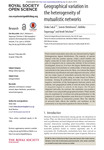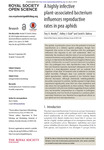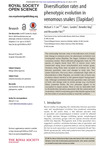Search
Now showing items 51-60 of 109
Geographical variation in the heterogeneity of mutualistic networks
(2016)
Plant–animal mutualistic networks are characterized by highly heterogeneous degree distributions. The majority of species interact with few partner species, while a small number are highly connected to form network hubs ...
The presence of lateral photophores correlates with increased speciation in deep-sea bioluminescent sharks
(2015)
The vast majority of species within the lanternshark genus Etmopterusharbour complex luminescent markings on their flanks, whose functional significance has long remained obscure. Recent studies, however, suggest these ...
A highly infective plant-associated bacterium influences reproductive rates in pea aphids
(2016)
Pea aphids, A cyrthosiphon pisum, have the potential to increase reproduction as a defence against pathogens, though how frequently this occurs or how infection with live pathogens influences this response is not well ...
Tools to tipple
(2015)
African apes and humans share a genetic mutation that enables them to effectively metabolize ethanol. However, voluntary ethanol consumption in this evolutionary radiation is documented only in modern humans. Here, we ...
Symbiotic bacteria enable olive fly larvae to overcome host defences
(2015)
Ripe fruit offer readily available nutrients for many animals, including fruit fly larvae (Diptera: Tephritidae) and their associated rot-inducing bacteria. Yet, during most of their ontogeny, fruit remain chemically ...
Comparative phylogenetic analyses uncover the ancient roots of Indo-European folktales
(2016)
Ancient population expansions and dispersals often leave enduring signatures in the cultural traditions of their descendants, as well as in their genes and languages. The international folktale record has long been regarded ...
Proximate causes of the red face of the bald uakari monkey
(2015)
In social species, such as primates, facial appearances transmit a variety of social signals. Although it is suggested that the intense red colour of the face of the bald uakari monkey might be an indicator of health, this ...
Diversification rates and phenotypic evolution in venomous snakes
(2016)
The relationship between rates of diversification and of body size change (a common proxy for phenotypic evolution) was investigated across Elapidae, the largest radiation of highly venomous snakes. Time-calibrated ...
Dopamine regulates termite soldier differentiation through trophallactic behaviours
(2016)
Caste polyphenism in social insects is regulated by social interactions among colony members. Trophallaxis is one of the most frequently observed interactions, but no studies have been conducted identifying the intrinsic ...
Do grandparents compete with or support their grandchildren?
(2016)
Previous research has found that the presence of grandparents, particularly grandmothers, is often positively associated with child survival. Little research has explored the potential mechanisms driving these associations. ...










